ENGL 111 Literature Exam Review: Plots, Themes, and Literary Periods
VerifiedAdded on 2022/09/12
|18
|2757
|32
Homework Assignment
AI Summary
This document serves as a comprehensive review for an ENGL 111 Introduction to Literature exam. It covers a wide array of literary terms, including allusion, metaphor, symbolism, and various poetic devices, providing definitions and examples for each. The review delves into the plots, characters, authors, themes, and literary movements of several short stories and plays, such as "The Cask of Amontillado," "The Birthmark," "Hamlet," and "Antigone." Furthermore, it examines the characteristics and time frames of various literary periods, including Realism, Romanticism, Modernism, and the Gothic Romanticism, as well as Greek Drama and Shakespearean Theatre. Additionally, it includes a section on various poets and their works. This review is designed to help students prepare thoroughly for their literature exam by providing a detailed overview of key concepts, works, and literary periods.
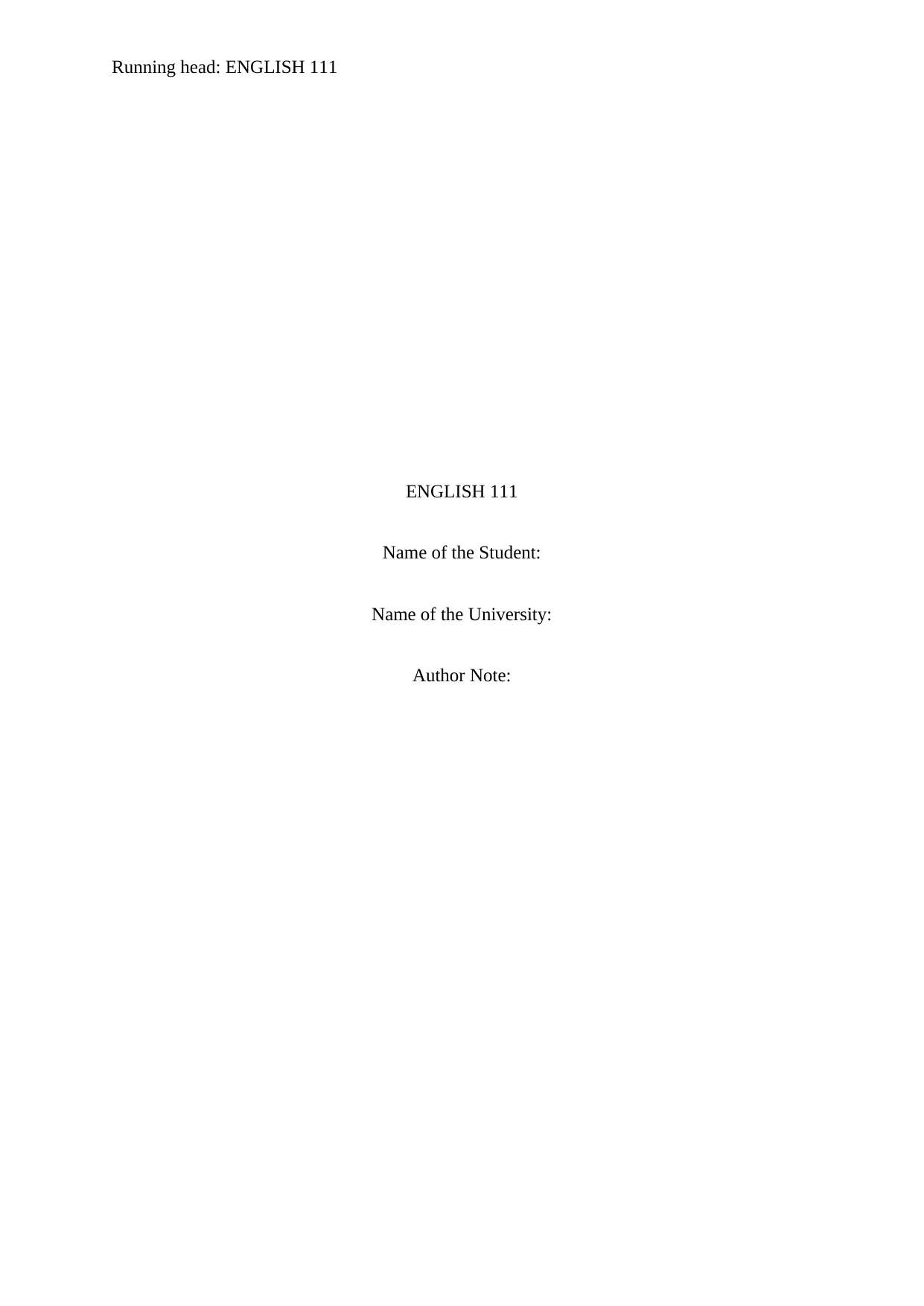
Running head: ENGLISH 111
ENGLISH 111
Name of the Student:
Name of the University:
Author Note:
ENGLISH 111
Name of the Student:
Name of the University:
Author Note:
Paraphrase This Document
Need a fresh take? Get an instant paraphrase of this document with our AI Paraphraser
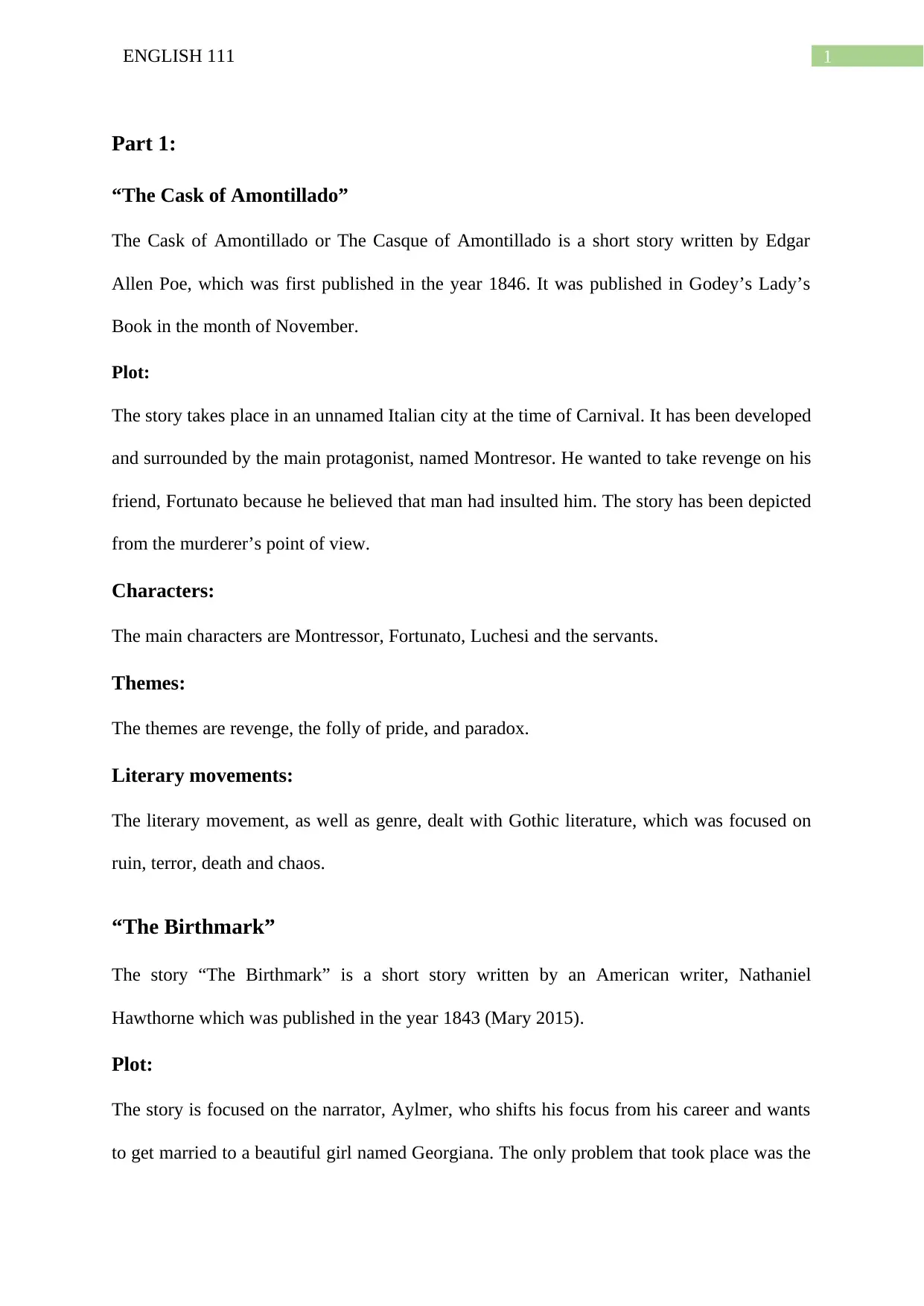
1ENGLISH 111
Part 1:
“The Cask of Amontillado”
The Cask of Amontillado or The Casque of Amontillado is a short story written by Edgar
Allen Poe, which was first published in the year 1846. It was published in Godey’s Lady’s
Book in the month of November.
Plot:
The story takes place in an unnamed Italian city at the time of Carnival. It has been developed
and surrounded by the main protagonist, named Montresor. He wanted to take revenge on his
friend, Fortunato because he believed that man had insulted him. The story has been depicted
from the murderer’s point of view.
Characters:
The main characters are Montressor, Fortunato, Luchesi and the servants.
Themes:
The themes are revenge, the folly of pride, and paradox.
Literary movements:
The literary movement, as well as genre, dealt with Gothic literature, which was focused on
ruin, terror, death and chaos.
“The Birthmark”
The story “The Birthmark” is a short story written by an American writer, Nathaniel
Hawthorne which was published in the year 1843 (Mary 2015).
Plot:
The story is focused on the narrator, Aylmer, who shifts his focus from his career and wants
to get married to a beautiful girl named Georgiana. The only problem that took place was the
Part 1:
“The Cask of Amontillado”
The Cask of Amontillado or The Casque of Amontillado is a short story written by Edgar
Allen Poe, which was first published in the year 1846. It was published in Godey’s Lady’s
Book in the month of November.
Plot:
The story takes place in an unnamed Italian city at the time of Carnival. It has been developed
and surrounded by the main protagonist, named Montresor. He wanted to take revenge on his
friend, Fortunato because he believed that man had insulted him. The story has been depicted
from the murderer’s point of view.
Characters:
The main characters are Montressor, Fortunato, Luchesi and the servants.
Themes:
The themes are revenge, the folly of pride, and paradox.
Literary movements:
The literary movement, as well as genre, dealt with Gothic literature, which was focused on
ruin, terror, death and chaos.
“The Birthmark”
The story “The Birthmark” is a short story written by an American writer, Nathaniel
Hawthorne which was published in the year 1843 (Mary 2015).
Plot:
The story is focused on the narrator, Aylmer, who shifts his focus from his career and wants
to get married to a beautiful girl named Georgiana. The only problem that took place was the
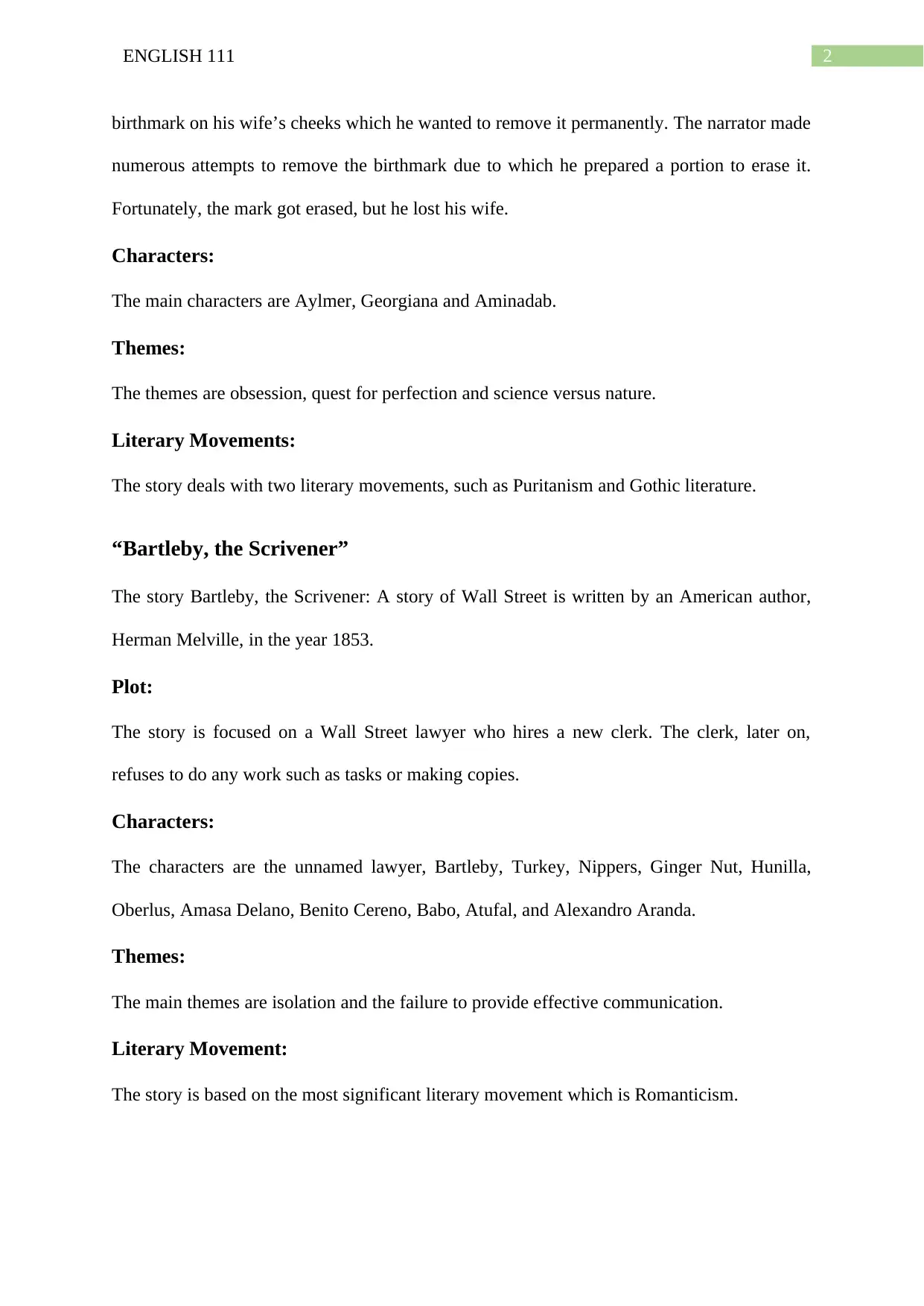
2ENGLISH 111
birthmark on his wife’s cheeks which he wanted to remove it permanently. The narrator made
numerous attempts to remove the birthmark due to which he prepared a portion to erase it.
Fortunately, the mark got erased, but he lost his wife.
Characters:
The main characters are Aylmer, Georgiana and Aminadab.
Themes:
The themes are obsession, quest for perfection and science versus nature.
Literary Movements:
The story deals with two literary movements, such as Puritanism and Gothic literature.
“Bartleby, the Scrivener”
The story Bartleby, the Scrivener: A story of Wall Street is written by an American author,
Herman Melville, in the year 1853.
Plot:
The story is focused on a Wall Street lawyer who hires a new clerk. The clerk, later on,
refuses to do any work such as tasks or making copies.
Characters:
The characters are the unnamed lawyer, Bartleby, Turkey, Nippers, Ginger Nut, Hunilla,
Oberlus, Amasa Delano, Benito Cereno, Babo, Atufal, and Alexandro Aranda.
Themes:
The main themes are isolation and the failure to provide effective communication.
Literary Movement:
The story is based on the most significant literary movement which is Romanticism.
birthmark on his wife’s cheeks which he wanted to remove it permanently. The narrator made
numerous attempts to remove the birthmark due to which he prepared a portion to erase it.
Fortunately, the mark got erased, but he lost his wife.
Characters:
The main characters are Aylmer, Georgiana and Aminadab.
Themes:
The themes are obsession, quest for perfection and science versus nature.
Literary Movements:
The story deals with two literary movements, such as Puritanism and Gothic literature.
“Bartleby, the Scrivener”
The story Bartleby, the Scrivener: A story of Wall Street is written by an American author,
Herman Melville, in the year 1853.
Plot:
The story is focused on a Wall Street lawyer who hires a new clerk. The clerk, later on,
refuses to do any work such as tasks or making copies.
Characters:
The characters are the unnamed lawyer, Bartleby, Turkey, Nippers, Ginger Nut, Hunilla,
Oberlus, Amasa Delano, Benito Cereno, Babo, Atufal, and Alexandro Aranda.
Themes:
The main themes are isolation and the failure to provide effective communication.
Literary Movement:
The story is based on the most significant literary movement which is Romanticism.
⊘ This is a preview!⊘
Do you want full access?
Subscribe today to unlock all pages.

Trusted by 1+ million students worldwide
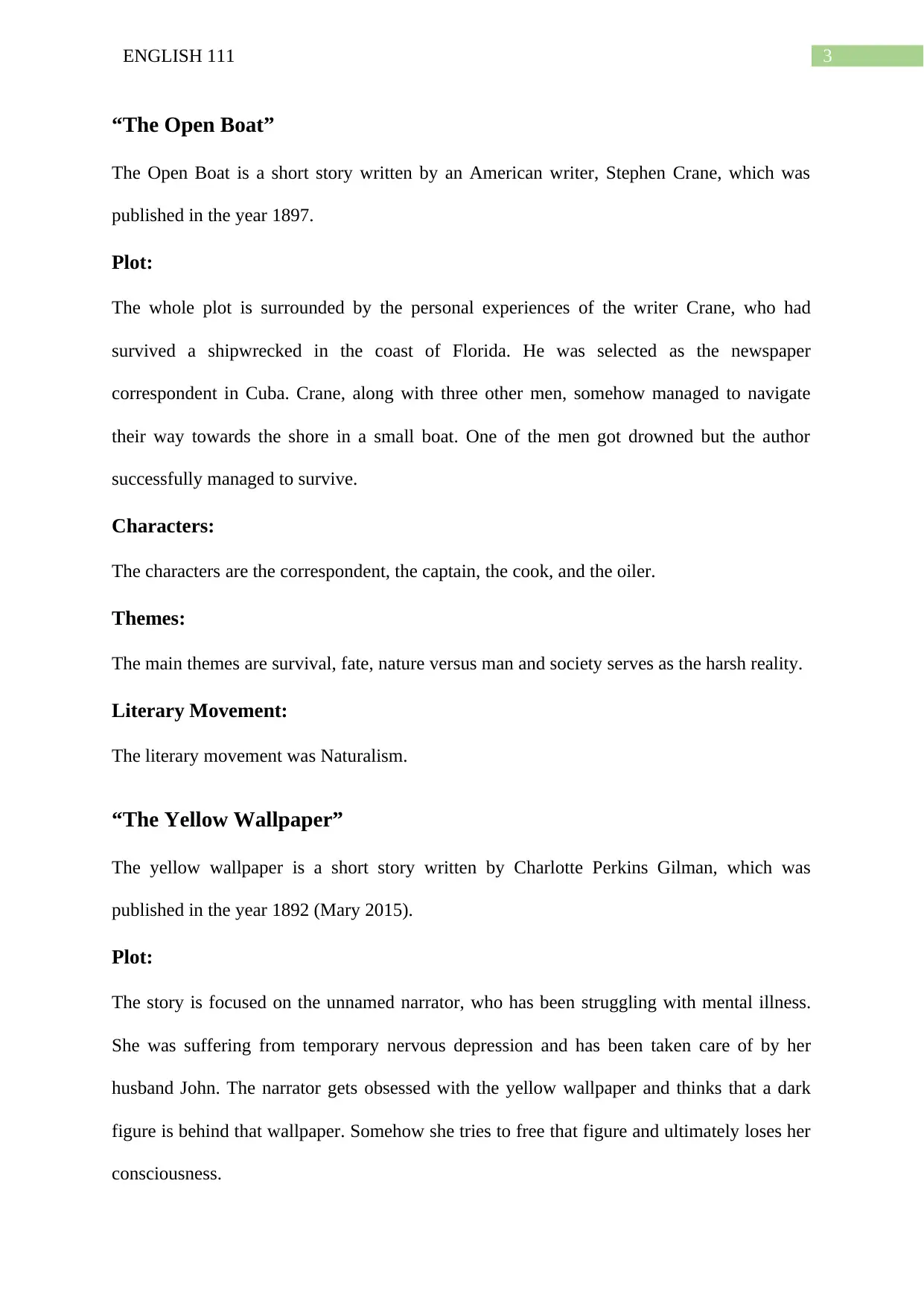
3ENGLISH 111
“The Open Boat”
The Open Boat is a short story written by an American writer, Stephen Crane, which was
published in the year 1897.
Plot:
The whole plot is surrounded by the personal experiences of the writer Crane, who had
survived a shipwrecked in the coast of Florida. He was selected as the newspaper
correspondent in Cuba. Crane, along with three other men, somehow managed to navigate
their way towards the shore in a small boat. One of the men got drowned but the author
successfully managed to survive.
Characters:
The characters are the correspondent, the captain, the cook, and the oiler.
Themes:
The main themes are survival, fate, nature versus man and society serves as the harsh reality.
Literary Movement:
The literary movement was Naturalism.
“The Yellow Wallpaper”
The yellow wallpaper is a short story written by Charlotte Perkins Gilman, which was
published in the year 1892 (Mary 2015).
Plot:
The story is focused on the unnamed narrator, who has been struggling with mental illness.
She was suffering from temporary nervous depression and has been taken care of by her
husband John. The narrator gets obsessed with the yellow wallpaper and thinks that a dark
figure is behind that wallpaper. Somehow she tries to free that figure and ultimately loses her
consciousness.
“The Open Boat”
The Open Boat is a short story written by an American writer, Stephen Crane, which was
published in the year 1897.
Plot:
The whole plot is surrounded by the personal experiences of the writer Crane, who had
survived a shipwrecked in the coast of Florida. He was selected as the newspaper
correspondent in Cuba. Crane, along with three other men, somehow managed to navigate
their way towards the shore in a small boat. One of the men got drowned but the author
successfully managed to survive.
Characters:
The characters are the correspondent, the captain, the cook, and the oiler.
Themes:
The main themes are survival, fate, nature versus man and society serves as the harsh reality.
Literary Movement:
The literary movement was Naturalism.
“The Yellow Wallpaper”
The yellow wallpaper is a short story written by Charlotte Perkins Gilman, which was
published in the year 1892 (Mary 2015).
Plot:
The story is focused on the unnamed narrator, who has been struggling with mental illness.
She was suffering from temporary nervous depression and has been taken care of by her
husband John. The narrator gets obsessed with the yellow wallpaper and thinks that a dark
figure is behind that wallpaper. Somehow she tries to free that figure and ultimately loses her
consciousness.
Paraphrase This Document
Need a fresh take? Get an instant paraphrase of this document with our AI Paraphraser
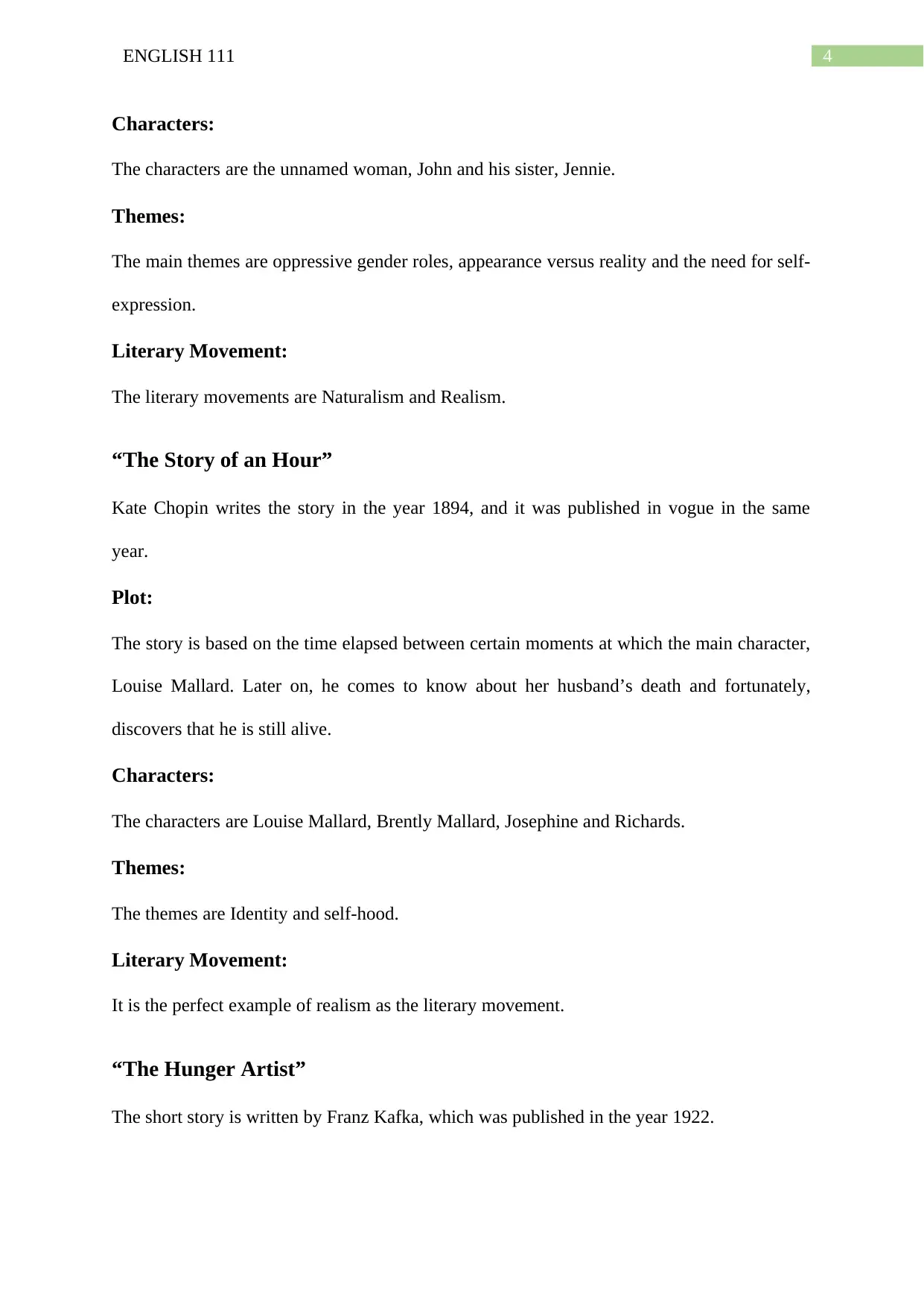
4ENGLISH 111
Characters:
The characters are the unnamed woman, John and his sister, Jennie.
Themes:
The main themes are oppressive gender roles, appearance versus reality and the need for self-
expression.
Literary Movement:
The literary movements are Naturalism and Realism.
“The Story of an Hour”
Kate Chopin writes the story in the year 1894, and it was published in vogue in the same
year.
Plot:
The story is based on the time elapsed between certain moments at which the main character,
Louise Mallard. Later on, he comes to know about her husband’s death and fortunately,
discovers that he is still alive.
Characters:
The characters are Louise Mallard, Brently Mallard, Josephine and Richards.
Themes:
The themes are Identity and self-hood.
Literary Movement:
It is the perfect example of realism as the literary movement.
“The Hunger Artist”
The short story is written by Franz Kafka, which was published in the year 1922.
Characters:
The characters are the unnamed woman, John and his sister, Jennie.
Themes:
The main themes are oppressive gender roles, appearance versus reality and the need for self-
expression.
Literary Movement:
The literary movements are Naturalism and Realism.
“The Story of an Hour”
Kate Chopin writes the story in the year 1894, and it was published in vogue in the same
year.
Plot:
The story is based on the time elapsed between certain moments at which the main character,
Louise Mallard. Later on, he comes to know about her husband’s death and fortunately,
discovers that he is still alive.
Characters:
The characters are Louise Mallard, Brently Mallard, Josephine and Richards.
Themes:
The themes are Identity and self-hood.
Literary Movement:
It is the perfect example of realism as the literary movement.
“The Hunger Artist”
The short story is written by Franz Kafka, which was published in the year 1922.
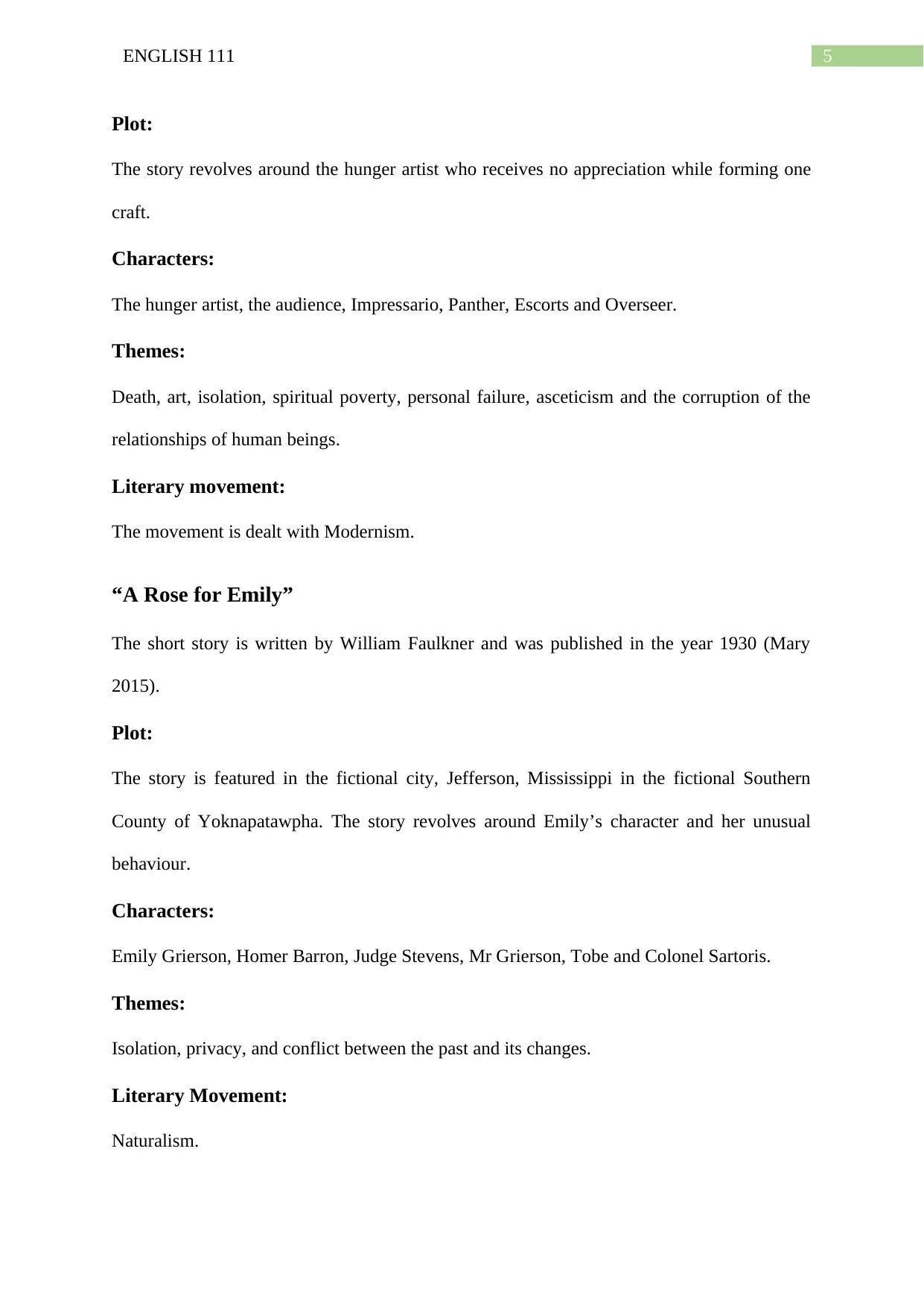
5ENGLISH 111
Plot:
The story revolves around the hunger artist who receives no appreciation while forming one
craft.
Characters:
The hunger artist, the audience, Impressario, Panther, Escorts and Overseer.
Themes:
Death, art, isolation, spiritual poverty, personal failure, asceticism and the corruption of the
relationships of human beings.
Literary movement:
The movement is dealt with Modernism.
“A Rose for Emily”
The short story is written by William Faulkner and was published in the year 1930 (Mary
2015).
Plot:
The story is featured in the fictional city, Jefferson, Mississippi in the fictional Southern
County of Yoknapatawpha. The story revolves around Emily’s character and her unusual
behaviour.
Characters:
Emily Grierson, Homer Barron, Judge Stevens, Mr Grierson, Tobe and Colonel Sartoris.
Themes:
Isolation, privacy, and conflict between the past and its changes.
Literary Movement:
Naturalism.
Plot:
The story revolves around the hunger artist who receives no appreciation while forming one
craft.
Characters:
The hunger artist, the audience, Impressario, Panther, Escorts and Overseer.
Themes:
Death, art, isolation, spiritual poverty, personal failure, asceticism and the corruption of the
relationships of human beings.
Literary movement:
The movement is dealt with Modernism.
“A Rose for Emily”
The short story is written by William Faulkner and was published in the year 1930 (Mary
2015).
Plot:
The story is featured in the fictional city, Jefferson, Mississippi in the fictional Southern
County of Yoknapatawpha. The story revolves around Emily’s character and her unusual
behaviour.
Characters:
Emily Grierson, Homer Barron, Judge Stevens, Mr Grierson, Tobe and Colonel Sartoris.
Themes:
Isolation, privacy, and conflict between the past and its changes.
Literary Movement:
Naturalism.
⊘ This is a preview!⊘
Do you want full access?
Subscribe today to unlock all pages.

Trusted by 1+ million students worldwide
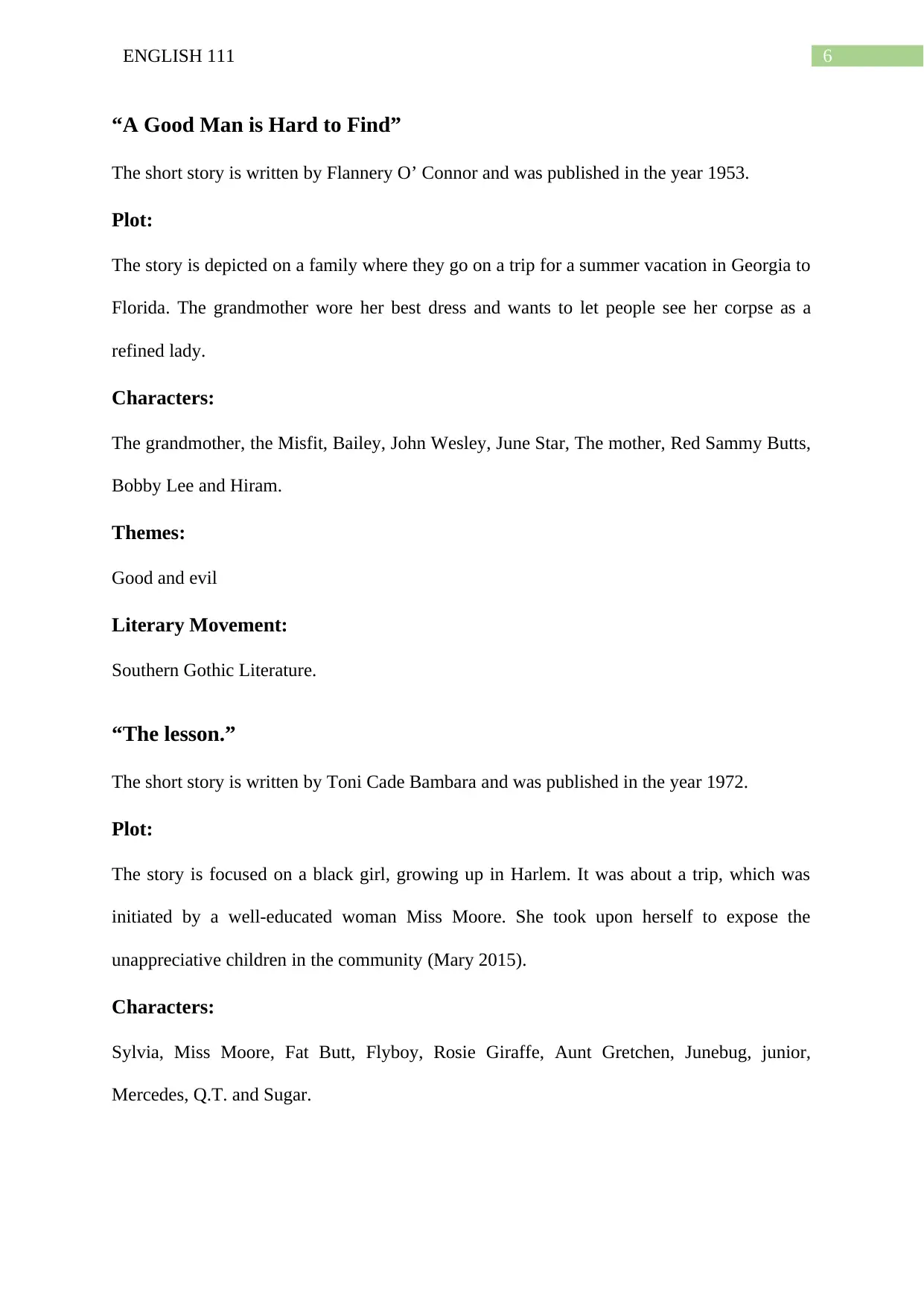
6ENGLISH 111
“A Good Man is Hard to Find”
The short story is written by Flannery O’ Connor and was published in the year 1953.
Plot:
The story is depicted on a family where they go on a trip for a summer vacation in Georgia to
Florida. The grandmother wore her best dress and wants to let people see her corpse as a
refined lady.
Characters:
The grandmother, the Misfit, Bailey, John Wesley, June Star, The mother, Red Sammy Butts,
Bobby Lee and Hiram.
Themes:
Good and evil
Literary Movement:
Southern Gothic Literature.
“The lesson.”
The short story is written by Toni Cade Bambara and was published in the year 1972.
Plot:
The story is focused on a black girl, growing up in Harlem. It was about a trip, which was
initiated by a well-educated woman Miss Moore. She took upon herself to expose the
unappreciative children in the community (Mary 2015).
Characters:
Sylvia, Miss Moore, Fat Butt, Flyboy, Rosie Giraffe, Aunt Gretchen, Junebug, junior,
Mercedes, Q.T. and Sugar.
“A Good Man is Hard to Find”
The short story is written by Flannery O’ Connor and was published in the year 1953.
Plot:
The story is depicted on a family where they go on a trip for a summer vacation in Georgia to
Florida. The grandmother wore her best dress and wants to let people see her corpse as a
refined lady.
Characters:
The grandmother, the Misfit, Bailey, John Wesley, June Star, The mother, Red Sammy Butts,
Bobby Lee and Hiram.
Themes:
Good and evil
Literary Movement:
Southern Gothic Literature.
“The lesson.”
The short story is written by Toni Cade Bambara and was published in the year 1972.
Plot:
The story is focused on a black girl, growing up in Harlem. It was about a trip, which was
initiated by a well-educated woman Miss Moore. She took upon herself to expose the
unappreciative children in the community (Mary 2015).
Characters:
Sylvia, Miss Moore, Fat Butt, Flyboy, Rosie Giraffe, Aunt Gretchen, Junebug, junior,
Mercedes, Q.T. and Sugar.
Paraphrase This Document
Need a fresh take? Get an instant paraphrase of this document with our AI Paraphraser
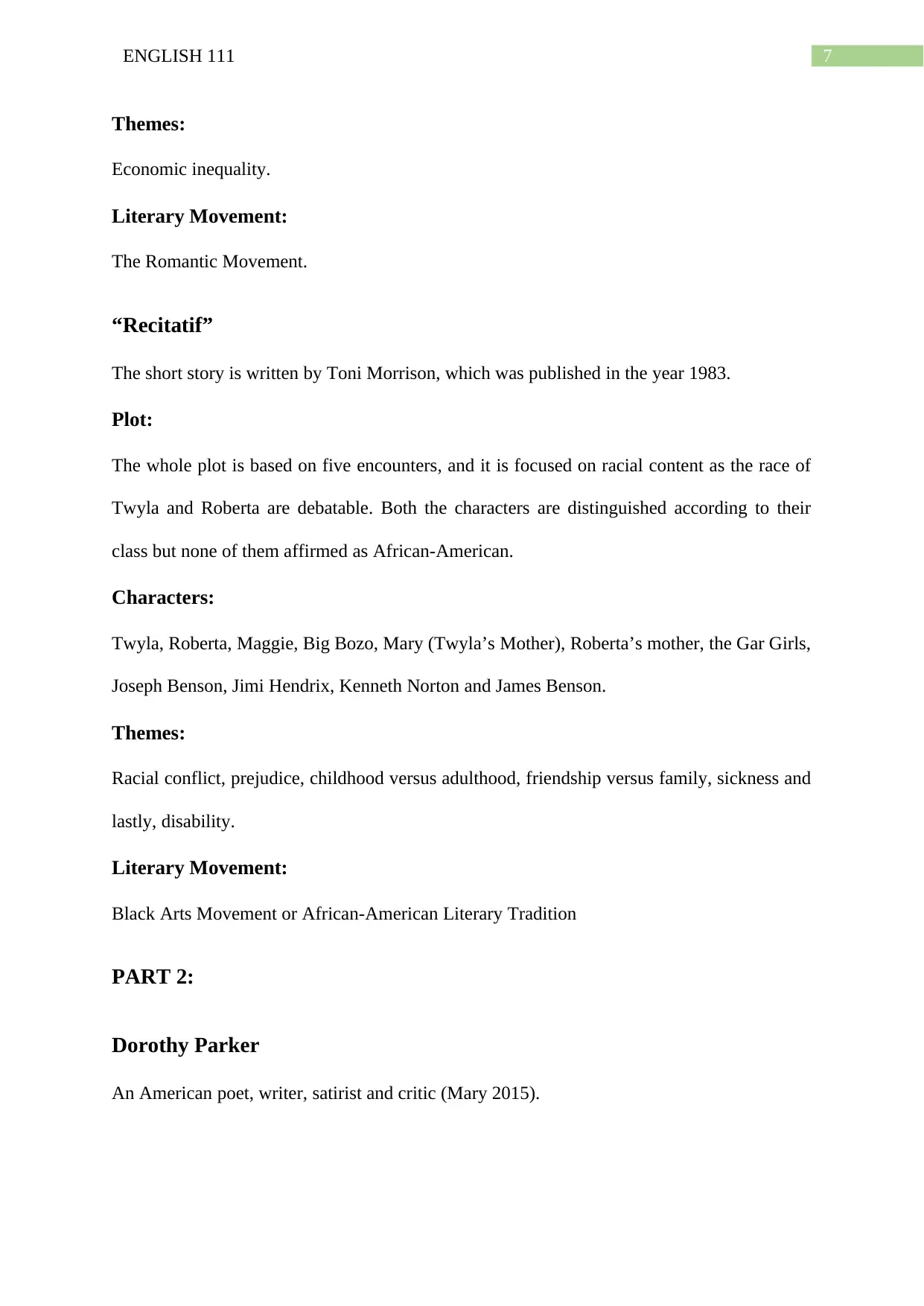
7ENGLISH 111
Themes:
Economic inequality.
Literary Movement:
The Romantic Movement.
“Recitatif”
The short story is written by Toni Morrison, which was published in the year 1983.
Plot:
The whole plot is based on five encounters, and it is focused on racial content as the race of
Twyla and Roberta are debatable. Both the characters are distinguished according to their
class but none of them affirmed as African-American.
Characters:
Twyla, Roberta, Maggie, Big Bozo, Mary (Twyla’s Mother), Roberta’s mother, the Gar Girls,
Joseph Benson, Jimi Hendrix, Kenneth Norton and James Benson.
Themes:
Racial conflict, prejudice, childhood versus adulthood, friendship versus family, sickness and
lastly, disability.
Literary Movement:
Black Arts Movement or African-American Literary Tradition
PART 2:
Dorothy Parker
An American poet, writer, satirist and critic (Mary 2015).
Themes:
Economic inequality.
Literary Movement:
The Romantic Movement.
“Recitatif”
The short story is written by Toni Morrison, which was published in the year 1983.
Plot:
The whole plot is based on five encounters, and it is focused on racial content as the race of
Twyla and Roberta are debatable. Both the characters are distinguished according to their
class but none of them affirmed as African-American.
Characters:
Twyla, Roberta, Maggie, Big Bozo, Mary (Twyla’s Mother), Roberta’s mother, the Gar Girls,
Joseph Benson, Jimi Hendrix, Kenneth Norton and James Benson.
Themes:
Racial conflict, prejudice, childhood versus adulthood, friendship versus family, sickness and
lastly, disability.
Literary Movement:
Black Arts Movement or African-American Literary Tradition
PART 2:
Dorothy Parker
An American poet, writer, satirist and critic (Mary 2015).
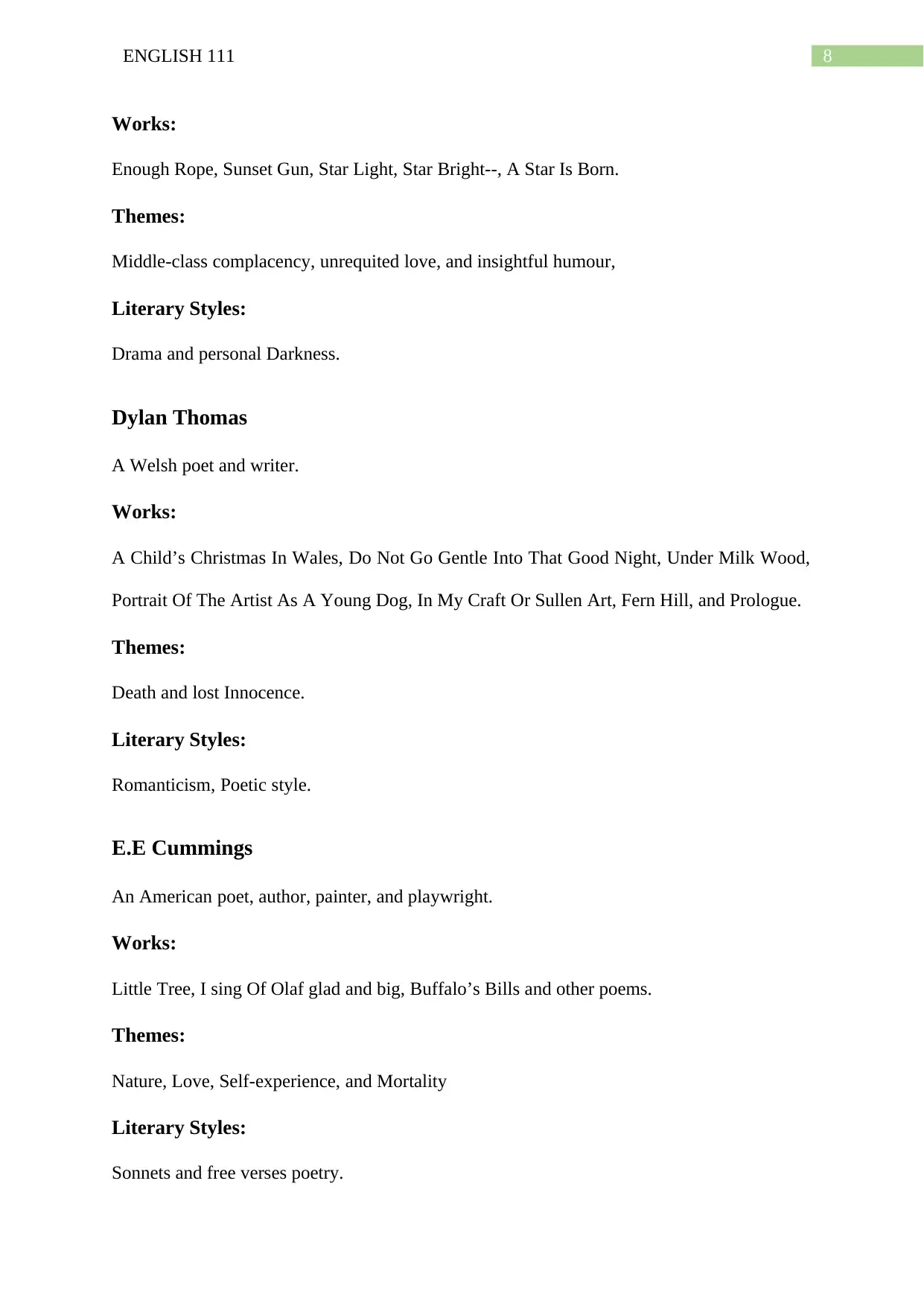
8ENGLISH 111
Works:
Enough Rope, Sunset Gun, Star Light, Star Bright--, A Star Is Born.
Themes:
Middle-class complacency, unrequited love, and insightful humour,
Literary Styles:
Drama and personal Darkness.
Dylan Thomas
A Welsh poet and writer.
Works:
A Child’s Christmas In Wales, Do Not Go Gentle Into That Good Night, Under Milk Wood,
Portrait Of The Artist As A Young Dog, In My Craft Or Sullen Art, Fern Hill, and Prologue.
Themes:
Death and lost Innocence.
Literary Styles:
Romanticism, Poetic style.
E.E Cummings
An American poet, author, painter, and playwright.
Works:
Little Tree, I sing Of Olaf glad and big, Buffalo’s Bills and other poems.
Themes:
Nature, Love, Self-experience, and Mortality
Literary Styles:
Sonnets and free verses poetry.
Works:
Enough Rope, Sunset Gun, Star Light, Star Bright--, A Star Is Born.
Themes:
Middle-class complacency, unrequited love, and insightful humour,
Literary Styles:
Drama and personal Darkness.
Dylan Thomas
A Welsh poet and writer.
Works:
A Child’s Christmas In Wales, Do Not Go Gentle Into That Good Night, Under Milk Wood,
Portrait Of The Artist As A Young Dog, In My Craft Or Sullen Art, Fern Hill, and Prologue.
Themes:
Death and lost Innocence.
Literary Styles:
Romanticism, Poetic style.
E.E Cummings
An American poet, author, painter, and playwright.
Works:
Little Tree, I sing Of Olaf glad and big, Buffalo’s Bills and other poems.
Themes:
Nature, Love, Self-experience, and Mortality
Literary Styles:
Sonnets and free verses poetry.
⊘ This is a preview!⊘
Do you want full access?
Subscribe today to unlock all pages.

Trusted by 1+ million students worldwide
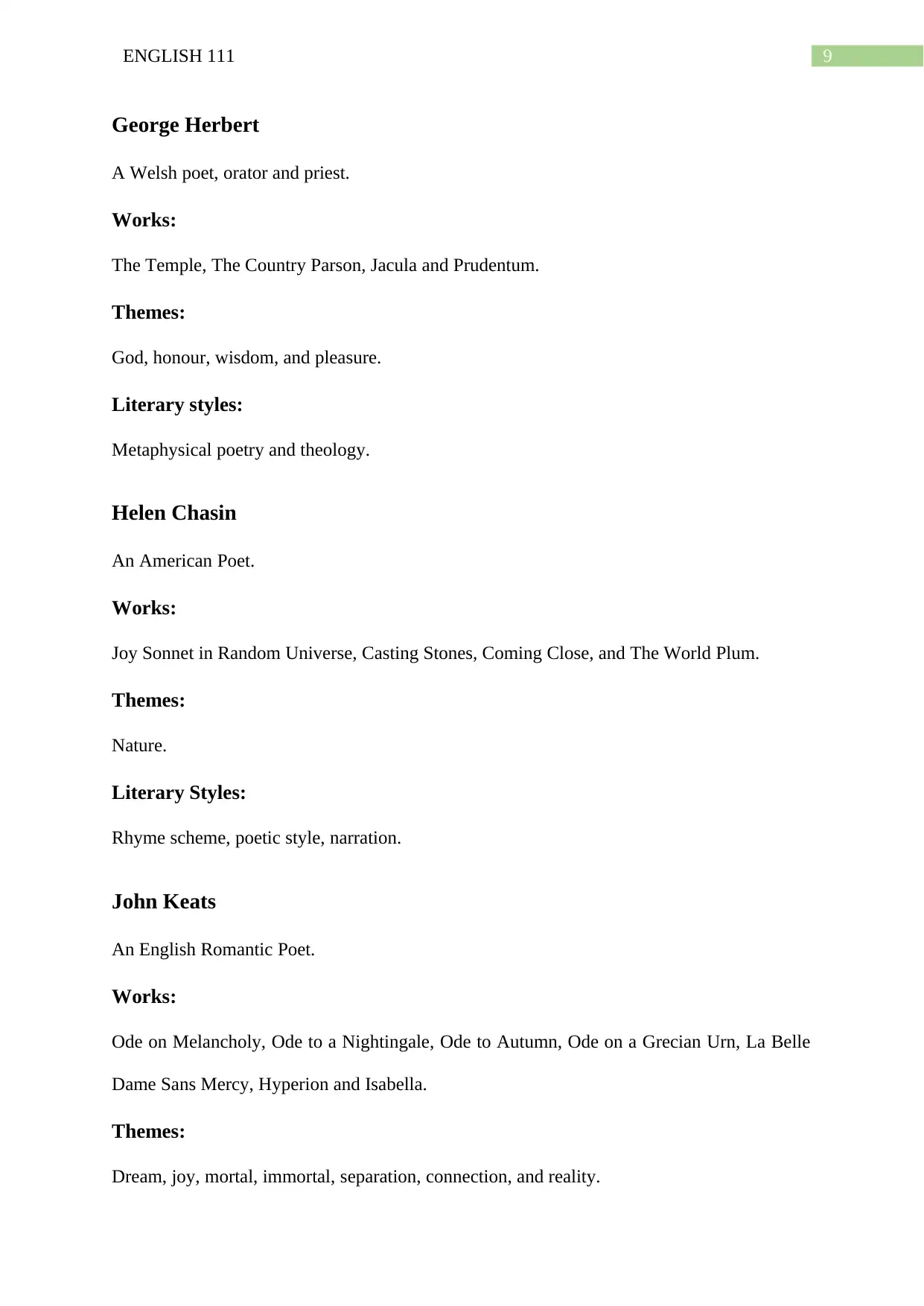
9ENGLISH 111
George Herbert
A Welsh poet, orator and priest.
Works:
The Temple, The Country Parson, Jacula and Prudentum.
Themes:
God, honour, wisdom, and pleasure.
Literary styles:
Metaphysical poetry and theology.
Helen Chasin
An American Poet.
Works:
Joy Sonnet in Random Universe, Casting Stones, Coming Close, and The World Plum.
Themes:
Nature.
Literary Styles:
Rhyme scheme, poetic style, narration.
John Keats
An English Romantic Poet.
Works:
Ode on Melancholy, Ode to a Nightingale, Ode to Autumn, Ode on a Grecian Urn, La Belle
Dame Sans Mercy, Hyperion and Isabella.
Themes:
Dream, joy, mortal, immortal, separation, connection, and reality.
George Herbert
A Welsh poet, orator and priest.
Works:
The Temple, The Country Parson, Jacula and Prudentum.
Themes:
God, honour, wisdom, and pleasure.
Literary styles:
Metaphysical poetry and theology.
Helen Chasin
An American Poet.
Works:
Joy Sonnet in Random Universe, Casting Stones, Coming Close, and The World Plum.
Themes:
Nature.
Literary Styles:
Rhyme scheme, poetic style, narration.
John Keats
An English Romantic Poet.
Works:
Ode on Melancholy, Ode to a Nightingale, Ode to Autumn, Ode on a Grecian Urn, La Belle
Dame Sans Mercy, Hyperion and Isabella.
Themes:
Dream, joy, mortal, immortal, separation, connection, and reality.
Paraphrase This Document
Need a fresh take? Get an instant paraphrase of this document with our AI Paraphraser
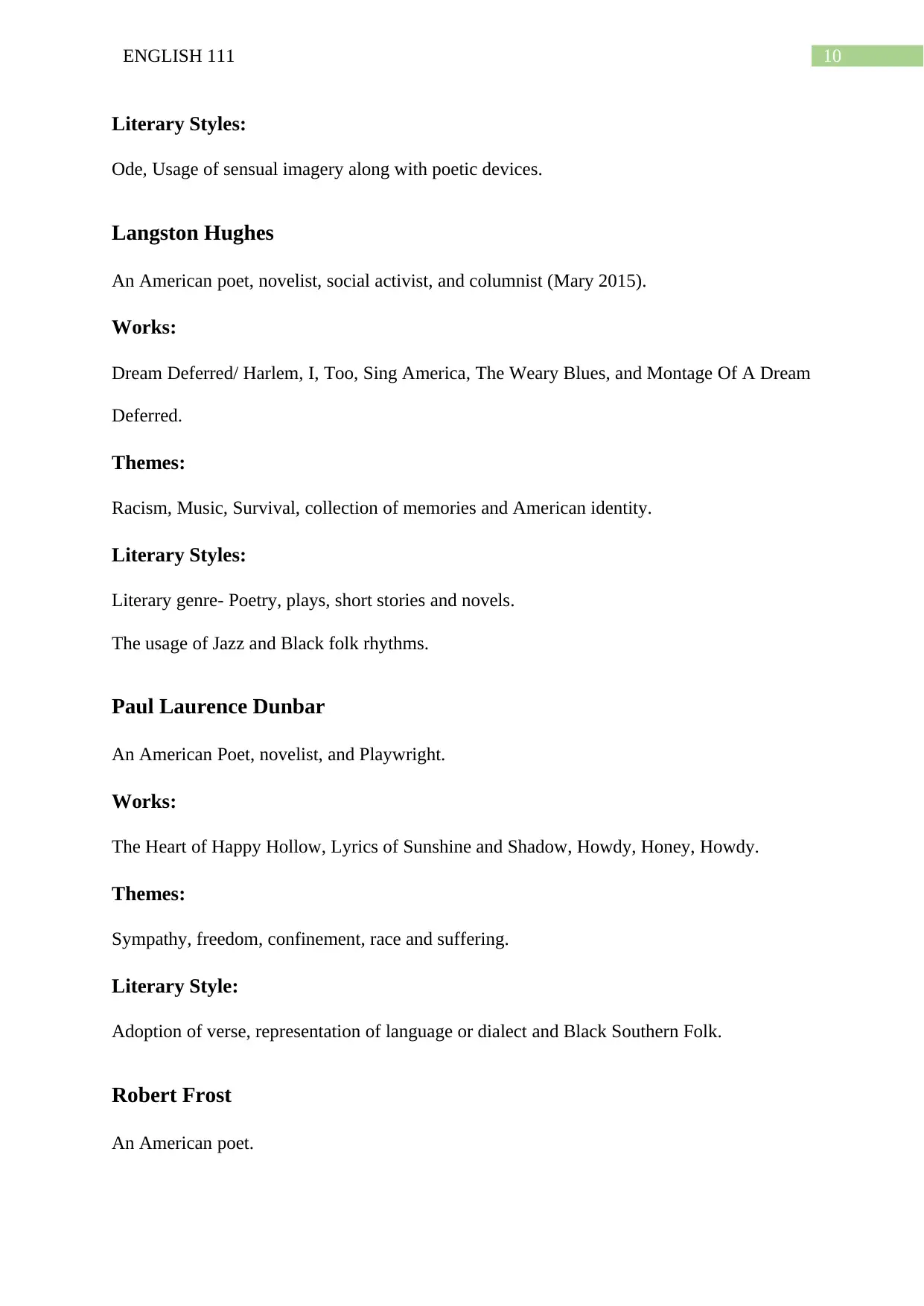
10ENGLISH 111
Literary Styles:
Ode, Usage of sensual imagery along with poetic devices.
Langston Hughes
An American poet, novelist, social activist, and columnist (Mary 2015).
Works:
Dream Deferred/ Harlem, I, Too, Sing America, The Weary Blues, and Montage Of A Dream
Deferred.
Themes:
Racism, Music, Survival, collection of memories and American identity.
Literary Styles:
Literary genre- Poetry, plays, short stories and novels.
The usage of Jazz and Black folk rhythms.
Paul Laurence Dunbar
An American Poet, novelist, and Playwright.
Works:
The Heart of Happy Hollow, Lyrics of Sunshine and Shadow, Howdy, Honey, Howdy.
Themes:
Sympathy, freedom, confinement, race and suffering.
Literary Style:
Adoption of verse, representation of language or dialect and Black Southern Folk.
Robert Frost
An American poet.
Literary Styles:
Ode, Usage of sensual imagery along with poetic devices.
Langston Hughes
An American poet, novelist, social activist, and columnist (Mary 2015).
Works:
Dream Deferred/ Harlem, I, Too, Sing America, The Weary Blues, and Montage Of A Dream
Deferred.
Themes:
Racism, Music, Survival, collection of memories and American identity.
Literary Styles:
Literary genre- Poetry, plays, short stories and novels.
The usage of Jazz and Black folk rhythms.
Paul Laurence Dunbar
An American Poet, novelist, and Playwright.
Works:
The Heart of Happy Hollow, Lyrics of Sunshine and Shadow, Howdy, Honey, Howdy.
Themes:
Sympathy, freedom, confinement, race and suffering.
Literary Style:
Adoption of verse, representation of language or dialect and Black Southern Folk.
Robert Frost
An American poet.
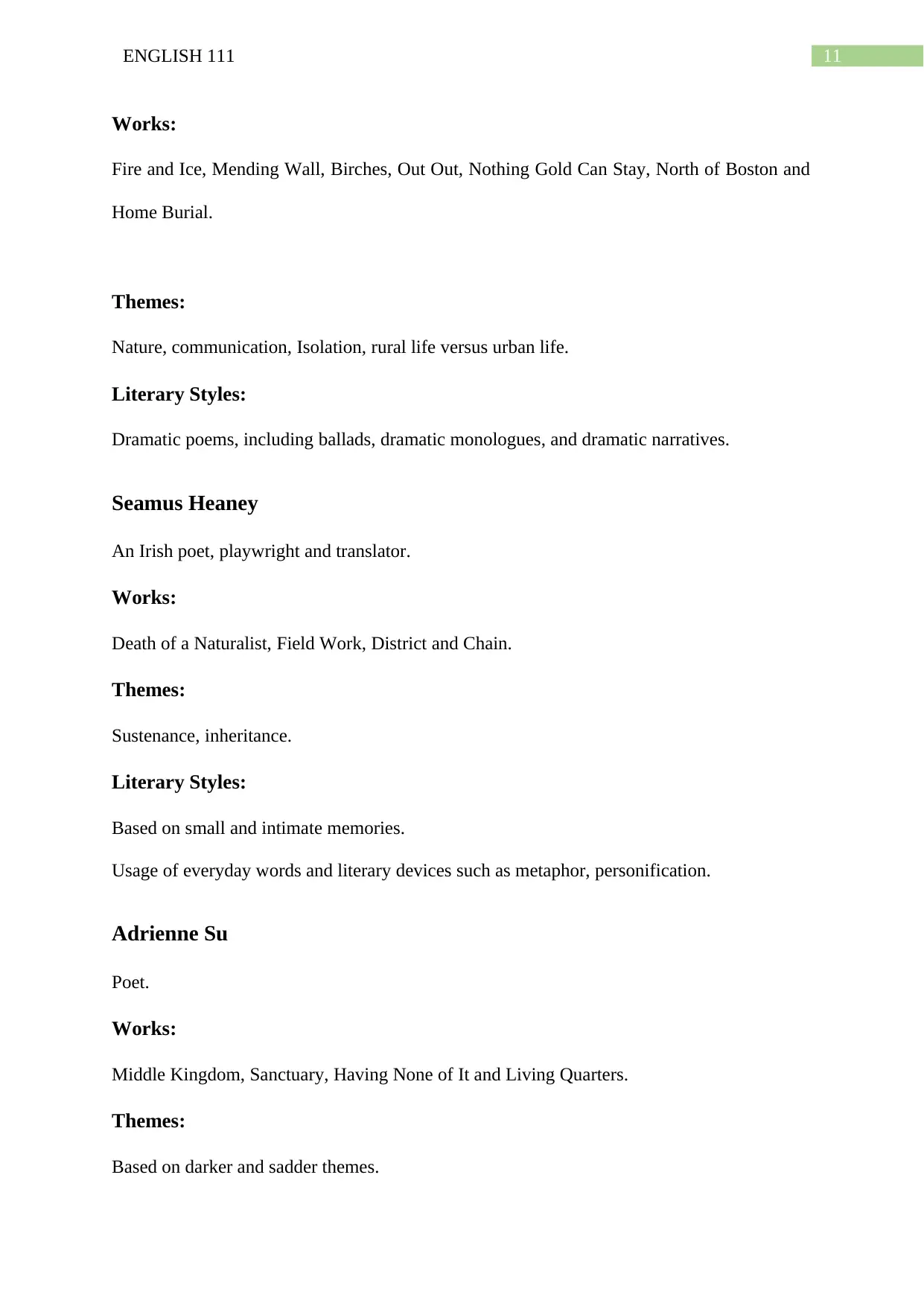
11ENGLISH 111
Works:
Fire and Ice, Mending Wall, Birches, Out Out, Nothing Gold Can Stay, North of Boston and
Home Burial.
Themes:
Nature, communication, Isolation, rural life versus urban life.
Literary Styles:
Dramatic poems, including ballads, dramatic monologues, and dramatic narratives.
Seamus Heaney
An Irish poet, playwright and translator.
Works:
Death of a Naturalist, Field Work, District and Chain.
Themes:
Sustenance, inheritance.
Literary Styles:
Based on small and intimate memories.
Usage of everyday words and literary devices such as metaphor, personification.
Adrienne Su
Poet.
Works:
Middle Kingdom, Sanctuary, Having None of It and Living Quarters.
Themes:
Based on darker and sadder themes.
Works:
Fire and Ice, Mending Wall, Birches, Out Out, Nothing Gold Can Stay, North of Boston and
Home Burial.
Themes:
Nature, communication, Isolation, rural life versus urban life.
Literary Styles:
Dramatic poems, including ballads, dramatic monologues, and dramatic narratives.
Seamus Heaney
An Irish poet, playwright and translator.
Works:
Death of a Naturalist, Field Work, District and Chain.
Themes:
Sustenance, inheritance.
Literary Styles:
Based on small and intimate memories.
Usage of everyday words and literary devices such as metaphor, personification.
Adrienne Su
Poet.
Works:
Middle Kingdom, Sanctuary, Having None of It and Living Quarters.
Themes:
Based on darker and sadder themes.
⊘ This is a preview!⊘
Do you want full access?
Subscribe today to unlock all pages.

Trusted by 1+ million students worldwide
1 out of 18
Your All-in-One AI-Powered Toolkit for Academic Success.
+13062052269
info@desklib.com
Available 24*7 on WhatsApp / Email
![[object Object]](/_next/static/media/star-bottom.7253800d.svg)
Unlock your academic potential
Copyright © 2020–2025 A2Z Services. All Rights Reserved. Developed and managed by ZUCOL.